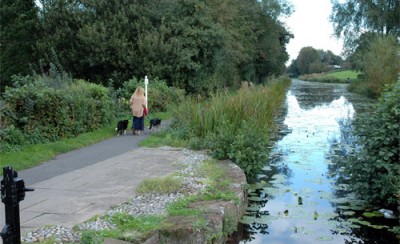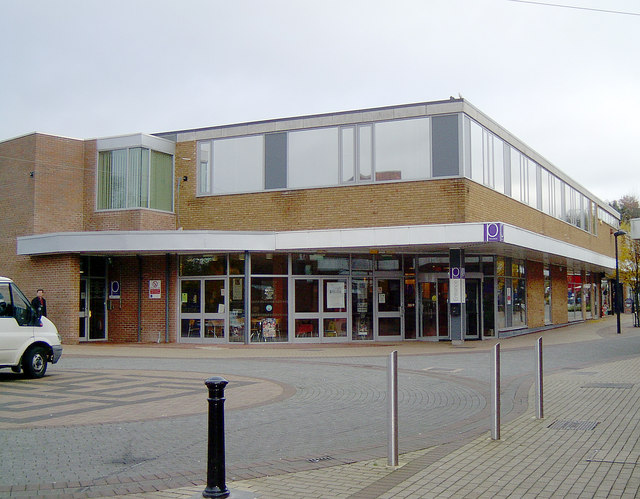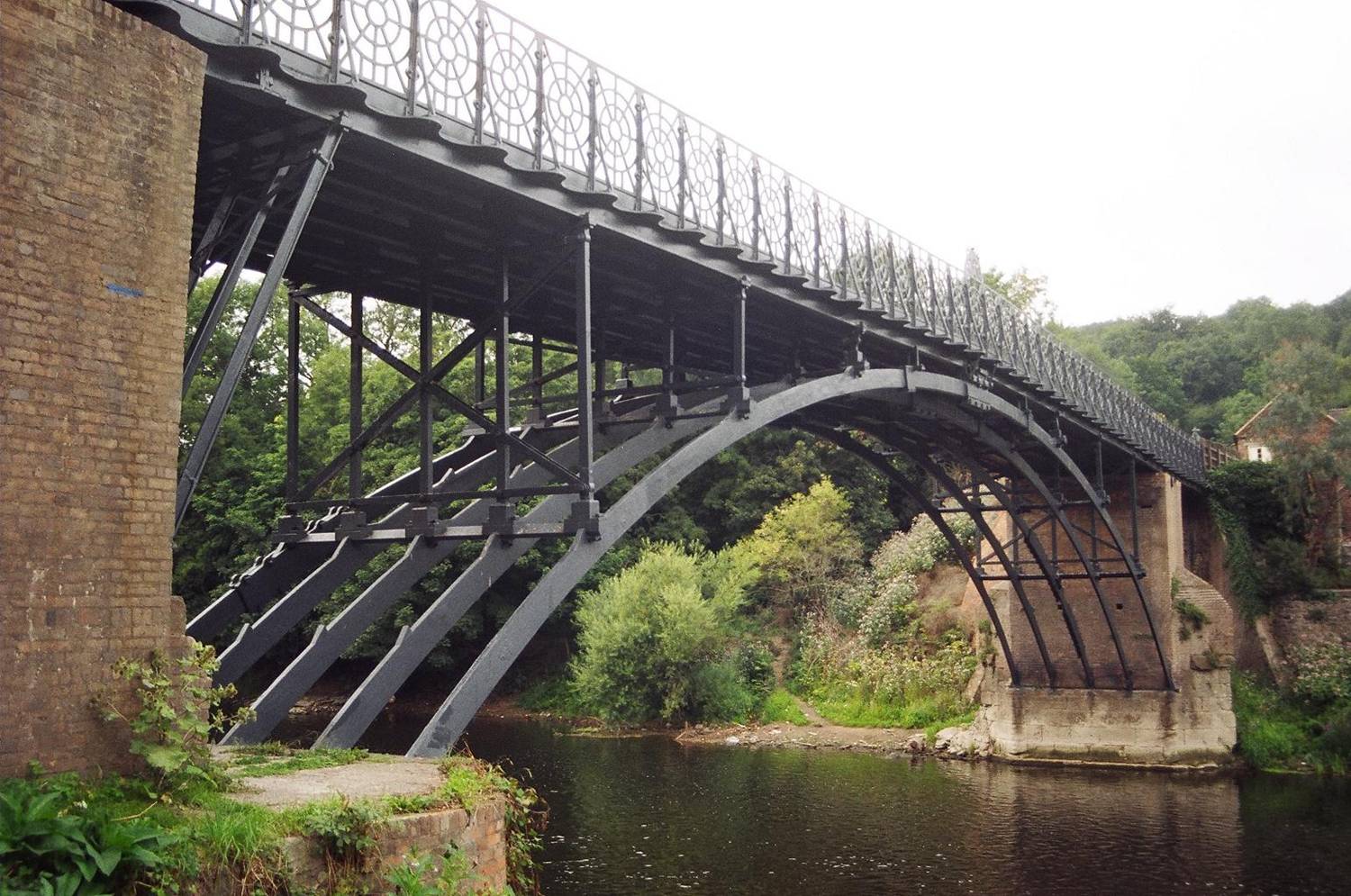|
Shrewsbury Canal
The Shrewsbury Canal (or Shrewsbury and Newport Canal) was a canal in Shropshire, England. Authorised in 1793, the main line from Trench to Shrewsbury was fully open by 1797, but it remained isolated from the rest of the canal network until 1835, when the Birmingham and Liverpool Junction Canal built the Newport Branch from Norbury Junction to a new junction with the Shrewsbury Canal at Wappenshall. After ownership passed to a series of railway companies, the canal was officially abandoned in 1944; many sections have disappeared, though some bridges and other structures can still be found. There is an active campaign to preserve the remnants of the canal and to restore the Norbury to Shrewsbury line to navigation. History From 1768 several small canals were built in the area of what is now Telford. These canals carried tub boats. The first of these was the Donnington Wood Canal which opened in 1768, to be followed by the Wombridge Canal and the Ketley Canal, both opened ... [...More Info...] [...Related Items...] OR: [Wikipedia] [Google] [Baidu] |
Longdon-on-Tern Aqueduct
The Longdon-upon-Tern Aqueduct, near Longdon-upon-Tern in Shropshire, was one of the first two canal aqueducts to be built from cast iron. History The cast iron canal aqueduct was re-engineered by Thomas Telford after the first construction designed by William Clowes was swept away by floods. It was built in 1796 to carry the Shrewsbury Canal across the River Tern near Longdon-upon-Tern in Shropshire. The aqueduct was opened one month after Benjamin Outram's cast iron Holmes Aqueduct on the Derby Canal, the world's first cast iron canal aqueduct. Since the closure of the Shrewsbury Canal in 1944, the aqueduct has been disused. The aqueduct is an Historic England Grade I listed building In the United Kingdom, a listed building is a structure of particular architectural or historic interest deserving of special protection. Such buildings are placed on one of the four statutory lists maintained by Historic England in England, Hi ... and has been on the register since ... [...More Info...] [...Related Items...] OR: [Wikipedia] [Google] [Baidu] |
Ketley Canal
The Ketley Canal was a tub boat canal that ran for about from Oakengates to Ketley works in Shropshire, England. The canal was built about 1788 and featured the first inclined plane in Britain. The main cargo of the canal was coal and ironstone (a form of iron ore). The inclined ceased to be used in 1816, when Ketley Works was closed, but the upper canal was not finally abandoned until the 1880s. A few traces of the canal are still visible in the landscape. History The Ketley canal was constructed between 1787 and 1788 by William Reynolds of Ketley. Reynolds was born in 1758 at Bank House, Ketley, the son of the ironmaster and philanthropist Richard Reynolds. His father managed the works at Coalbrookdale from 1763 to 1768, following the death of Abraham Darby II and the coming of age of his son, Abraham Darby III. Reynolds served his apprenticeship while his father was manager, and it was a period of great innovation, including the first use of iron rails. He became the mos ... [...More Info...] [...Related Items...] OR: [Wikipedia] [Google] [Baidu] |
Montgomery Canal
The Montgomery Canal (), known colloquially as "The Monty", is a partially restored canal in eastern Powys and northwest Shropshire. The canal runs from the Llangollen Canal at Frankton Junction to Newtown, Powys, Newtown via Llanymynech and Welshpool and crosses the England–Wales border. The canal was formally named as the Montgomery Canal in the British Waterways Act 1987. However, it was informally known by this name prior to this act. It consists of the Eastern and Western branches of the Montgomeryshire Canal and the Llanymynech Branch of the Ellesmere Canal. The Montgomeryshire Canal ran from Llanymynech to Newtown. It was named after the county of Montgomeryshire that it ran through and was divided into Western and Eastern branches which met at Garthmyl. At Carreghofa Locks near Llanymynech, the Montgomeryshire Canal connected to the Llanymynech Branch of the Ellesmere Canal. The Llanymynech Branch ran from Carreghofa Locks to Frankton Junction where it meets the pre ... [...More Info...] [...Related Items...] OR: [Wikipedia] [Google] [Baidu] |
Llangollen Canal
The Llangollen Canal () is a navigable canals of the United Kingdom, canal crossing the border between England and Wales. The waterway links Llangollen in Denbighshire, north Wales, with Hurleston in south Cheshire, via the town of Ellesmere, Shropshire. The name, which was coined in the 1980s, is a modern designation for parts of the historic Ellesmere Canal and the Llangollen navigable feeder, both of which became part of the Shropshire Union Railways and Canal Company, Shropshire Union Canals in 1846. The Ellesmere Canal was proposed by industrialists at Ruabon and Brymbo, and two disconnected sections were built. The northern section ran from Ellesmere Port on the River Mersey to Chester, where it joined the Chester Canal, and opened in 1795. Work on the southern section began at Frankton, with a line southwards to Llanymynech, and subsequently, a second section was built westwards towards Trevor. This involved crossing the River Ceiriog, Afon Ceiriog and the River Dee, Wale ... [...More Info...] [...Related Items...] OR: [Wikipedia] [Google] [Baidu] |
Chester
Chester is a cathedral city in Cheshire, England, on the River Dee, Wales, River Dee, close to the England–Wales border. With a built-up area population of 92,760 in 2021, it is the most populous settlement in the borough of Cheshire West and Chester. It is also the historic county town of Cheshire and the List of Cheshire settlements by population, second-largest settlement in Cheshire after Warrington. Chester was founded in 79 AD as a "Castra, castrum" or Roman Empire, Roman fort with the name Deva Victrix during the reign of Emperor Vespasian. One of the main army camps in Roman Britain, Deva later became a major civilian settlement. In 689, Æthelred of Mercia, King Æthelred of Mercia founded the Minster Church of West Mercia, which later became Chester's first cathedral, and the Angles (tribe), Angles extended and strengthened the walls to protect the city against the Danes (Germanic tribe), Danes. Chester was one of the last cities in England to Norman conquest of Eng ... [...More Info...] [...Related Items...] OR: [Wikipedia] [Google] [Baidu] |
Ellesmere Canal
The Ellesmere Canal was a waterway in England and Wales that was planned to carry boat traffic between the rivers Mersey and Severn. The proposal would create a link between the Port of Liverpool and the mineral industries in north east Wales and the manufacturing centres in the West Midlands. However, the canal was never completed as intended because of its rising costs and failure to generate the expected commercial traffic. The Ellesmere Canal, which was first proposed in 1791, would have created a waterway between Netherpool, Cheshire, and Shrewsbury. However, only certain sections were completed; these were eventually incorporated into the Chester Canal, Montgomery Canal and Shropshire Union Canal. Although several major civil engineering feats were accomplished, major building work ceased following the completion of the Pontcysyllte Aqueduct in 1805. The northern end of the navigation's mainline ended from Chester at Trevor Basin near Ruabon and its southern end was at ... [...More Info...] [...Related Items...] OR: [Wikipedia] [Google] [Baidu] |
William Reynolds (industrialist)
William Reynolds (14 April 1758 – 3 June 1803) was an ironmaster and a partner in the ironworks in Coalbrookdale in Shropshire, England. He was interested in advances in science and industry, and invented the inclined plane for canals. Early life He was born at Bank House in Ketley near Coalbrookdale, son of Richard Reynolds who was in charge of Abraham Darby II's ironworks at Ketley. Around 1777 he took over the management of the works there.''The Coalbrookdale Ironworks: a short history''. Ironbridge Gorge Museum Trust, 1975. William Reynolds's education included some time studying with the physician and chemist Joseph Black. Reynolds during his life maintained his interest in many branches of science, including chemistry, geology and mineralogy, and he had a laboratory at his home Bank House, at Ketley Bank. He was interested in the application of science in industry. With Abraham Darby he built under licence several Boulton and Watt steam engines, an early type of ... [...More Info...] [...Related Items...] OR: [Wikipedia] [Google] [Baidu] |
Donnington Wood
Donnington Wood is suburb of Donnington in the borough of Telford and Wrekin and ceremonial county of Shropshire, England. First-class cricketer and coal miner Enoch Tranter (1842-1910), player for Lancashire, died at Donnington Wood. Jockey Sir Gordon Richards was born in Donnington Wood at Ivy Row, part of a new demolished row of cottages on whose site are the apartment blocks 'Gordon House' and 'Richards House'.Article by Toby Neal, part of series on Midlands worthies. A local pub in nearby Donnington was named after him: "The Champion Jockey". This was replaced firstly by a Netto supermarket which itself in 2011 became a Morrisons' supermarket, which then turned into a Home Bargains T.J. Morris Limited (trading as Home Bargains) is a British variety store and garden centre chain founded in 1976 by Tom Morris in Liverpool, England, as Home and Bargain. History The retailer was founded by owner Tom Morris in 1976 as a sing ... shop in 2015. References Donnington ... [...More Info...] [...Related Items...] OR: [Wikipedia] [Google] [Baidu] |
Ketley
Ketley is a large village and civil parish in the borough of Telford and Wrekin of Shropshire, England. It is located between the outlying towns of Oakengates, Telford and Wellington. Residential development East Ketley is currently being re-developed as part of the Telford Millennium Community, part of the Millennium Communities Programme. It will consist of around 750 new homes and some live/work units, a new primary school, some small offices and retail and leisure services in a masterplan designed by Lifschutz Davidson Sandilands. The site originally consisted of just a small terrace of Victorian houses amid old mineshafts, colliery spoil, a golf course (which was later used as a driving range) and playing fields. Most of the site has been left fallow for many years and some areas have become locally important habitats for wildlife. Industrial development Ketley was formerly the home of Ketley Ironworks. William Reynolds (the ironmaster of the works in the late 18th ... [...More Info...] [...Related Items...] OR: [Wikipedia] [Google] [Baidu] |
Oakengates
Oakengates is a historic market town and civil parish in the borough of Telford and Wrekin, Shropshire, England. The town's parish population was recorded as 8,517 in the 2001 census. Etymology The name is not derived from "oak" or "gates" but is derived from the Ancient Brythonic name for the valley which was Usc-con, meaning The Lake (''Usc'' (water)) and the confluence (''Cond'') of two streams (see Cartlidge), and from the Old Norse ''gata'', path; see gh- in Indo-European roots. meaning boundary or Road. So Usc-con gait is at the Road at the vale of Usc-con. ''The Vales and Gates of Usc-Con: A history of Oakengates'' was written by local historian Reverend J.E.G. Cartlidge whose name is commemorated in the name of the retirement home Cartlidge House. History Roman Period In 48 A.D, Watling Street, a pretty important road for transportation and travel, was built by the romans. The road passed directly through what is nowadays known as Oakengates and was sorrounded ... [...More Info...] [...Related Items...] OR: [Wikipedia] [Google] [Baidu] |
Coalport
Coalport is a village in Shropshire, England. It is located on the River Severn in the Ironbridge Gorge, a mile downstream of Ironbridge. It lies predominantly on the north bank of the river; on the other side is Jackfield. It forms part of the civil parish of the Gorge and is the south-eastern corner of the borough of Telford and Wrekin. History The settlement was planned as a canal–river interchange by ironmaster William Reynolds, who built warehouses, workshops, factories and workers' accommodation in Coalport between 1788 and 1796. He also directed the construction of the Shropshire Canal, linking the East Shropshire Coalfield with the River Severn — the terminus being Coalport Wharf between the Brewery Inn and Coalport Bridge. Coalport was, at this time, much larger than it is today. Cast iron bridge The Coalport Bridge of cast iron was built in 1818 and unlike its even more famous neighbour at Ironbridge, still takes vehicular traffic, albeit limited to a ... [...More Info...] [...Related Items...] OR: [Wikipedia] [Google] [Baidu] |






